The Best Patellofemoral Knee Brace
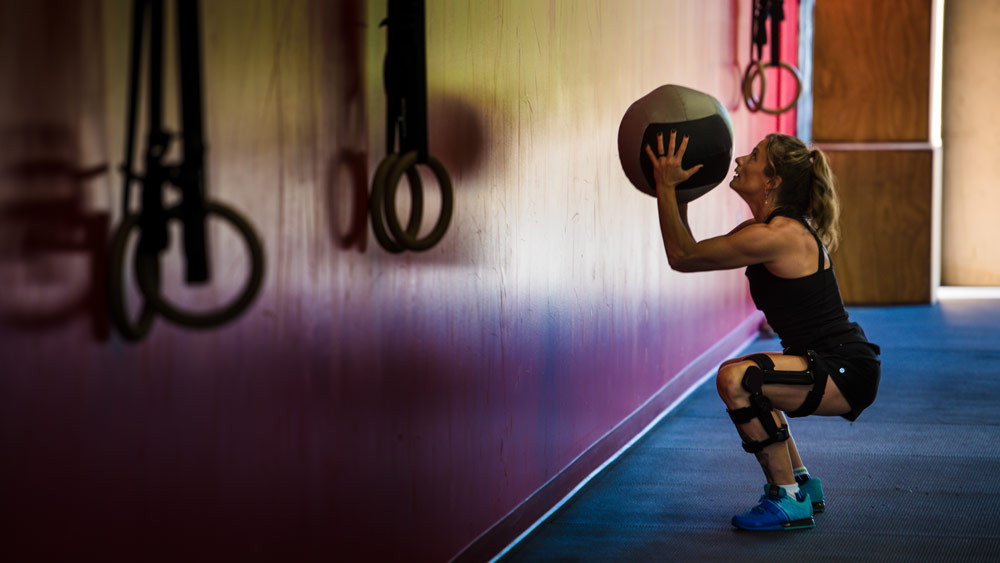
Patellofemoral knee pain (pain originating under the kneecap) usually occurs while squatting, using the stairs, or getting up from a chair. If you have it or think you might, rest assured that there are effective patellofemoral pain treatments out there. In this article, we break down what patellofemoral knee pain is, what causes it, and the best patellofemoral knee braces to help you manage your condition.
Patellofemoral knee pain is a common condition. For example, a recent study involving almost 4,000 knees with osteoarthritis demonstrated how common it is. For 63% of the population, the patellofemoral compartment was at least partially to blame for the symptoms3. Based on this, if your knee pain originates from your patella, know that you are not alone!
Brief overview of knee anatomy
Your knee is a complex body part. Its complexity leaves it at risk for developing many different types of injuries and diseases. Consequently, the first step in finding an appropriate treatment for a patellofemoral condition will be to understand the basic anatomy of your knee. After outlining your anatomy, we will dive into the specifics of what causes patellofemoral knee pain.
There are three compartments within the knee. These three compartments are created by three bones: the femur, the tibia, and the patella (also known as your kneecap). The compartments are separated by cartilage and meniscus, and are held in alignment with the aid of ligaments, tendons, and muscles.
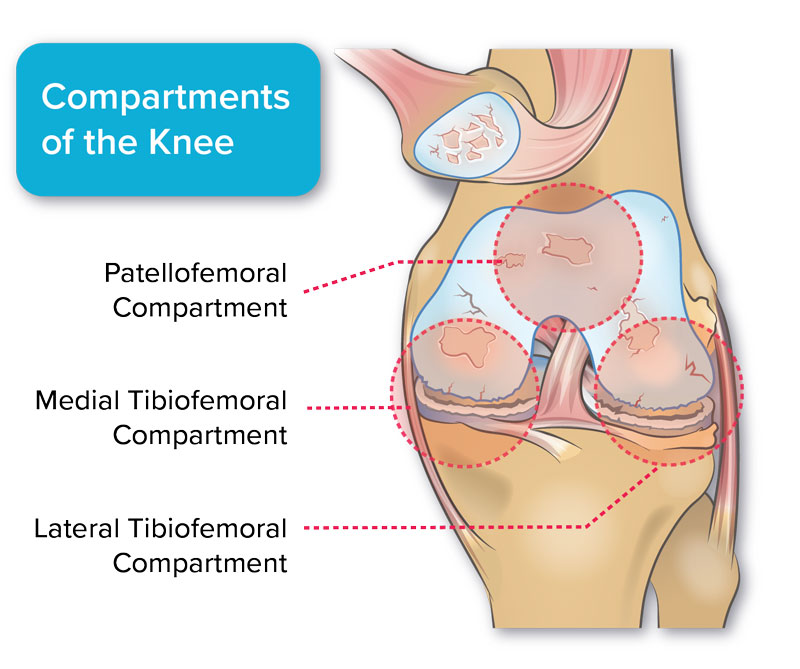
One compartment is located on the front of your knee where your patella and femur interact. This compartment is called the patellofemoral compartment. If you have patellofemoral knee pain, this area is where your condition arises.
Your two side compartments occur where your tibia and femur interact, which is why they are known as the tibiofemoral compartments. Because these two compartments are located on the inside (medial) and outside (lateral) parts of your knee, they are called the medial and lateral tibiofemoral compartments.
Do I have patellofemoral knee pain?
Patellofemoral knee pain originates in the patellofemoral compartment. To recap, this compartment is located where your patella meets your femur. But how do I know if my pain is coming from this compartment? Generally, you can tell which compartment is affected depending on the types of activities that cause pain.
For example, if you experience pain while standing still or walking on flat surfaces, the pain likely involves one or both of your side compartments. In comparison, if you experience pain in the front of your knee while performing deep knee bends, your patellofemoral compartment is likely involved2. It is also possible to have pain coming from both the tibiofemoral compartment(s) and the patellofemoral compartment, in which case you will likely experience pain while standing straight and while bending your knees.
The reason different activities affect different knee compartments comes down to how bent your knee is. The degree to which your knee is bent during activities directly impacts which compartment is being loaded1. When you are standing still or walking on flat surfaces, your knee will be bent less than 20 degrees when bearing weight. In these cases, your side compartments will receive the most pressure. In contrast, activities like using the stairs, squatting, jumping, running, and rising from a seated position involve deeper knee bends (30-90 degrees). These activities apply more pressure to your patellofemoral compartment.
Is your pain not quite like any of the categories above? You may be able to tell what condition you have based on whether your pain is on the inside or outside of your joint.
To understand your pain in more depth, take a look at our Complete Guide to Knee Pain.
What causes patellofemoral knee pain?
Most patellofemoral knee conditions stem from these three problems:
- Mis-alignment: When your patella is not moving within the trochlear groove
- Tendon Inflammation: When you overuse your patellar or quadriceps tendon
- Increased friction: When you have degeneration in your articular cartilage
These three problems can occur for a handful of reasons. For example, if your quadriceps muscles are weak, tight, or imbalanced, your patella may not align properly within the trochlear groove4. Unfortunately, human bones have natural variations in their shapes. Some of these variations, such as raised patella (patella alta), can lead to alignment problems in your knee5.
Swelling of your patellar or quadriceps tendon, which is often diagnosed as tendonitis, is another culprit. This swelling occurs when very small tears weaken and irritate your tendon. These tears often occur from performing the same movement (for example, jumping many times in a row).
Thankfully, tears in your tendon are one of the easier patellofemoral injuries to recover from. The swelling will decrease after an adequate amount of rest and recovery6,7. However, it is important to check in with your healthcare professional to ensure the strain does not progress into a tear or chronic tendinopathy (degeneration of collagen proteins in your tendon). These two conditions may require more aggressive treatments.
The other major cause of knee pain, and one of most difficult to manage, is articular cartilage degeneration. This can occur as a natural form of wear and tear as your age8, much like the wear seen on your favourite pair of running shoes. This wear and tear can happen quicker than normal if it is paired with patellar mis-alignment9, excessive body weight10, previous traumatic injury11, or diseases such as rheumatoid arthritis12.
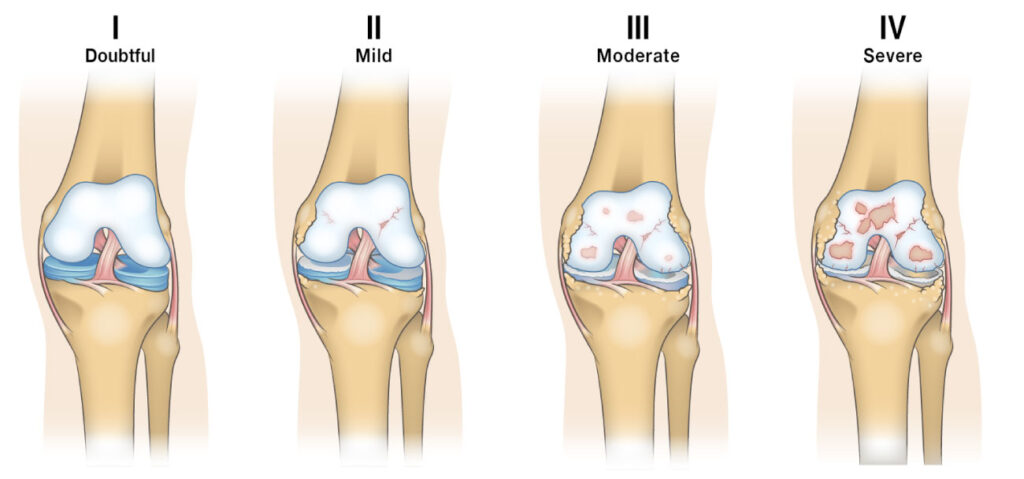
Patellofemoral knee braces
Early treatment options for patellofemoral knee pain usually include rest, anti-inflammatories, and physical therapy13. Additional early treatment options are activity modification, weight loss, injections, and a patellofemoral knee brace14.
There are many patellofemoral knee braces available on the market, including some that will work for you and some that won’t. These braces are designed to function differently, so it is important to understand the nature of your patellofemoral pain.
If your patellofemoral condition originates from a misalignment of your patella or minor swelling of your tendons, you may benefit from a strap or a soft brace. Alternatively, if your condition includes the degeneration of one of the structures within your knee you may want something more stable.
Degenerative knee conditions include tendinopathy, cartilage defects, or osteoarthritis. If you have one of these, you may benefit from a brace that provides stability and also offloads pressure between your femur and patella.
Patellar Tendon Straps for Overuse of the Patellar Tendon
A patellar tendon strap is a band which goes under your kneecap, and puts pressure on the patella tendon. A patellar tendon strap may be recommended in the early treatment of overuse injuries, for example, if you experience patellofemoral knee while running or jumping while playing your favourite sport.
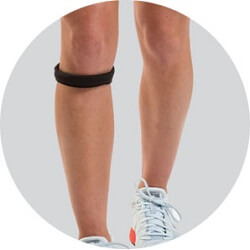
Patellar straps may be an appropriate option if your condition is mild or isolated to your patellar tendon. While these straps have shown to decrease pain in some athletes, note that their effectiveness is still under study.
Tendon straps have been marketed as a treatment for patellofemoral pain for over 30 years. These straps have been noted to decrease pain in certain athletes, but the reason why they achieve this pain reduction is not known15. Some theories state that these straps reduce localized tendon strain by using pressure to change the orientation of the tendon. Other theories say that these straps increase proprioception (awareness of how your knee is moving), which can make you more aware of your knee alignment and therefore reduce injury15,16.
Before getting a ptaellar strap, it is important to understand that the effectiveness of this type of brace for managing patellofemoral injury is a research topic that requires further investigation15.
Soft Knee Braces for Patellofemoral Pain
Also called knee sleeves, soft knee braces are made from cloth or neoprene. These braces are usually intended to apply compression around your knee. When they are fitted correctly, their purpose is to increase blood flow, provide warmth, and limit the movement of your patella17. Some of these soft braces include specific padding, called buttresses, or cut-outs. These structures apply compression around the kneecap to keep it in place.
Generally, soft braces are used for preventative measures. You may benefit from them if you engage in high-risk activities18 or experience high levels of muscle fatigue19. Activities that would call for soft braces include military training, weight-lifting, and soccer.
However, there is a lack of evidence for realignment braces or buttress or patella sleeves for treating chronic patellofemoral pain14. These sleeves are better suited for preventing wear and tear on your patellofemoral joint. In reality, soft braces do not provide rigid support. Consequently, they cannot offload pressure within the patellofemoral joint. Offloading pressure is one of the best ways to treat knee pain caused by degeneration.
Patellofemoral Knee Braces
In general, if your patellofemoral condition is moderate or severe, you will require a patellofemoral knee brace. But what is a patellofemoral knee brace? This type of brace is hinged and has a rigid frame that can provide stability and protection. Most importantly, a patellofemoral knee brace can offload the patellofemoral compartment.
Unfortunately, most hinged knee braces with rigid frames will not be able to offload the patellofemoral compartment. These braces are called uni-compartment offloaders. These braces work by shifting the pressure from the inside of your knee to the outside or vice versa20, 21.
Uni-compartment offloaders can only target symptoms in one tibiofemoral compartment of your knee. Since they redistribute pressure between your two side compartments, they cannot manage any symptoms that originate from the patellofemoral compartment22.
The only brace that meets the criteria for a patellofemoral knee brace is a tri-compartment offloader (TCO) knee brace. A TCO knee brace is a hinged rigid-frame brace that offloads the entire knee. It works by increasing your joint space and reducing pressure across all three knee compartments. If your patellofemoral knee condition is due to degeneration, reducing the pressure that naturally occurs will help reduce your symptoms.
Until recently, there was no brace capable of reducing the forces within your patellofemoral compartment. However, this has recently changed with the invention of Levitation, the world’s first tri-compartment offloader knee brace.
The Levitation Knee Brace
The Levitation knee brace is the world’s first and only knee brace proven to offload the patellofemoral compartment of the knee23, 24. Its unique hinge was designed to bridge the treatment gap of uni-compartment offloader knee braces. Because it offloads the patellofemoral knee compartment, Levitation is an effective patellofemoral knee brace.
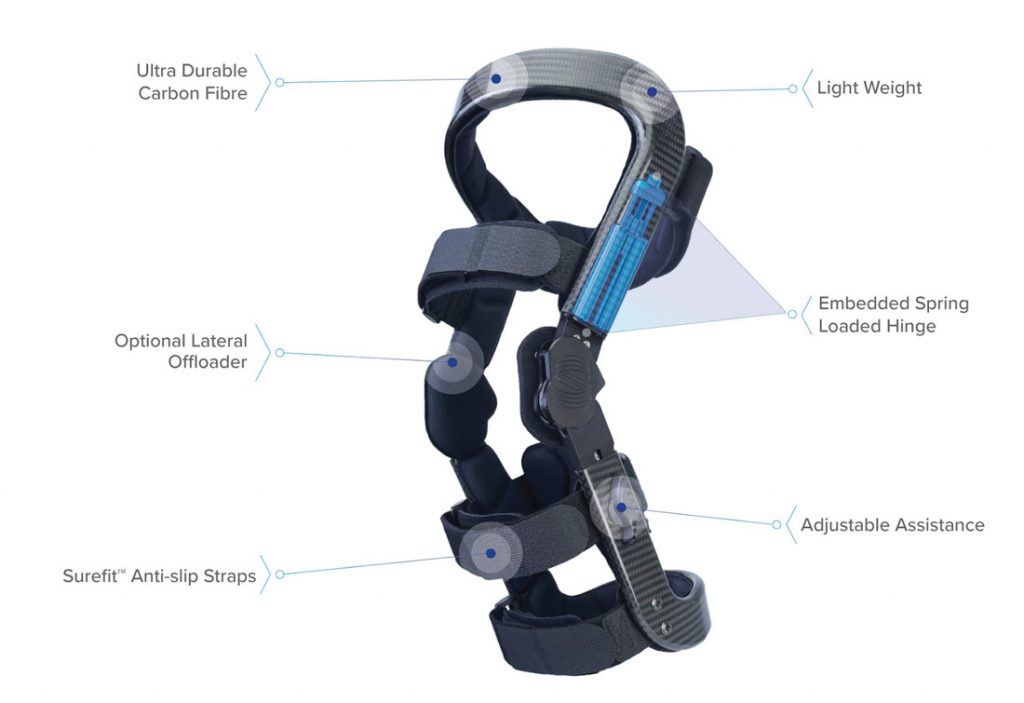
Still unsure what makes Levitation different? Take a look at how this brace compares to traditional knee braces on the market:
How does Levitation work? This innovative brace uses patented spring-loaded technology. Its hinge absorbs energy as you bend your knee, and then returns that energy when you straighten your leg. Its technology allows it to simultaneously reduce joint forces in both the medial and lateral tibiofemoral compartments, and most importantly, the patellofemoral compartment.
The Levitation knee brace is the appropriate choice for many knee conditions, including patellofemoral pain. Many injuries and diseases can benefit from its knee extension assist and offloading capabilities.
If you want more information on how to choose a knee brace, check out this guide for everything you need to know.
References
- F. H. Fu, M. J. Seel, and R. A. Berger, Patellofemoral biomechanics. The Patellofemoral Joint, Fox, JM, and W Del Pizzo. New York: NY: McGraw-Hill, 1993.
- R. Duncan, G. Peat, E. Thomas, L. Wood, E. Hay, and P. Croft, “Does isolated patellofemoral osteoarthritis matter?,” Osteoarthritis and Cartilage, vol. 17, no. 9, pp. 1151–1155, Sep. 2009, doi: 10.1016/j.joca.2009.03.016.
- J. C. Stoddart, O. Dandridge, A. Garner, J. Cobb, and R. J. van Arkel, “The compartmental distribution of knee osteoarthritis – a systematic review and meta-analysis,” Osteoarthritis and Cartilage, vol. 29, no. 4, pp. 445–455, Apr. 2021, doi: 10.1016/j.joca.2020.10.011.
- F. Lin, G. Wang, J. L. Koh, R. W. Hendrix, and L.-Q. Zhang, “In vivo and Noninvasive Three-Dimensional Patellar Tracking Induced by Individual Heads of Quadriceps:,” Medicine & Science in Sports & Exercise, vol. 36, no. 1, pp. 93–101, Jan. 2004, doi: 10.1249/01.MSS.0000106260.45656.CC.
- S. R. Ward, M. R. Terk, and C. M. Powers, “Patella Alta: Association with Patellofemoral Alignment and Changes in Contact Area During Weight-Bearing,” The Journal of Bone & Joint Surgery, vol. 89, no. 8, pp. 1749–1755, Aug. 2007, doi: 10.2106/JBJS.F.00508.
- “Patellar Tendonitis (Jumper’s Knee),” John Hopkins Medicine. https://www.hopkinsmedicine.org/health/conditions-and-diseases/patellar-tendonitis-jumpers-knee. (accessed May 20, 2021).
- “Patellar Tendonitis,” Emory Healthcare. https://www.emoryhealthcare.org/orthopedics/patellar-tendonitis.html (accessed May 20, 2021).
- D. R. Carter, G. S. Beaupré, M. Wong, R. L. Smith, T. P. Andriacchi, and D. J. Schurman, “The Mechanobiology of Articular Cartilage Development and Degeneration,” Clinical Orthopaedics & Related Research, vol. 427, pp. S69–S77, Oct. 2004, doi: 10.1097/01.blo.0000144970.05107.7e.
- L. Wang et al., “Relationship between knee alignment and T1ρ values of articular cartilage and menisci in patients with knee osteoarthritis,” European Journal of Radiology, vol. 82, no. 11, pp. 1946–1952, Nov. 2013, doi: 10.1016/j.ejrad.2013.05.010.
- Z.-Y. Zhou, Y.-K. Liu, H.-L. Chen, and F. Liu, “Body mass index and knee osteoarthritis risk: A dose-response meta-analysis: Body Mass Index and Knee Osteoarthritis Risk,” Obesity, vol. 22, no. 10, pp. 2180–2185, Oct. 2014, doi: 10.1002/oby.20835.
- A. M. Bhosale and J. B. Richardson, “Articular cartilage: structure, injuries and review of management,” British Medical Bulletin, vol. 87, no. 1, pp. 77–95, Aug. 2008, doi: 10.1093/bmb/ldn025.
- M. Ostrowska, W. Maśliński, M. Prochorec-Sobieszek, M. Nieciecki, and I. Sudoł-Szopińska, “Cartilage and bone damage in rheumatoid arthritis,” r, vol. 56, no. 2, pp. 111–120, 2018, doi: 10.5114/reum.2018.75523.
- L. Bolgla and T. Malone, “Exercise Prescription and Patellofemoral Pain: Evidence for Rehabilitation,” Journal of Sport Rehabilitation, vol. 14, no. 1, p. 72, Feb. 2005.
- M. Hrubes and T. L. Nicola, “Rehabilitation of the Patellofemoral Joint,” Clinics in Sports Medicine, vol. 33, no. 3, pp. 553–566, Jul. 2014, doi: 10.1016/j.csm.2014.03.009.
- A. de Vries et al., “Effect of patellar strap and sports tape on pain in patellar tendinopathy: A randomized controlled trial: Effect strap and tape jumper’s knee symptoms,” Scand J Med Sci Sports, vol. 26, no. 10, pp. 1217–1224, Oct. 2016, doi: 10.1111/sms.12556.
- M. Lavagnino, S. P. Arnoczky, J. Dodds, and N. Elvin, “Infrapatellar Straps Decrease Patellar Tendon Strain at the Site of the Jumper’s Knee Lesion: A Computational Analysis Based on Radiographic Measurements,” Sports Health, vol. 3, no. 3, pp. 296–302, May 2011, doi: 10.1177/1941738111403108.
- N. A. Mohd Sharif, S.-L. Goh, J. Usman, and W. K. Z. Wan Safwani, “Biomechanical and functional efficacy of knee sleeves: A literature review,” Physical Therapy in Sport, vol. 28, pp. 44–52, Nov. 2017, doi: 10.1016/j.ptsp.2017.05.001.
- D. Van Tiggelen, E. Witvrouw, P. Roget, D. Cambier, L. Danneels, and R. Verdonk, “Effect of bracing on the prevention of anterior knee pain—a prospective randomized study,” Knee Surg Sports Traumatol Arthrosc, vol. 12, no. 5, pp. 434–439, Sep. 2004, doi: 10.1007/s00167-003-0479-z.
- D. Van Tiggelen, P. Coorevits, and E. Witvrouw, “The use of a neoprene knee sleeve to compensate the deficit in knee joint position sense caused by muscle fatigue: Deficit in knee joint position sense,” Scandinavian Journal of Medicine & Science in Sports, vol. 18, no. 1, pp. 62–66, May 2007, doi: 10.1111/j.1600-0838.2007.00649.x.
- K. Briem and D. K. Ramsey, “The Role of Bracing,” Sports Medicine and Arthroscopy Review, vol. 21, no. 1, pp. 11–17, Mar. 2013, doi: 10.1097/JSA.0b013e31827562b5.
- D. K. Ramsey and M. E. Russell, “Offloader Braces for Medial Compartment Knee Osteoarthritis: Implications on Mediating Progression,” Sports Health, vol. 1, no. 5, pp. 416–426, Sep. 2009, doi: 10.1177/1941738109343157.
- R. D. Heekin and A. A. Fokin, “Incidence of bicompartmental osteoarthritis in patients undergoing total and unicompartmental knee arthroplasty: is the time ripe for a less radical treatment?,” J Knee Surg, vol. 27, no. 1, pp. 77–81, Feb. 2014, doi: 10.1055/s-0033-1349401.
- C. A. McGibbon, S. Brandon, E. L. Bishop, C. Cowper-Smith, and E. N. Biden, “Biomechanical Study of a Tricompartmental Offloader Brace for Patellofemoral or Multicompartment Knee Osteoarthritis,” Front. Bioeng. Biotechnol., vol. 8, 2021, doi: 10.3389/fbioe.2020.604860.
- A. R. Budarick, B. E. MacKeil, S. Fitzgerald, and C. D. Cowper-Smith, “Design Evaluation of a Novel Multicompartment Offloader Knee Brace,” J Biomech Eng, vol. 142, no. 1, Jan. 2020, doi: 10.1115/1.4044818.